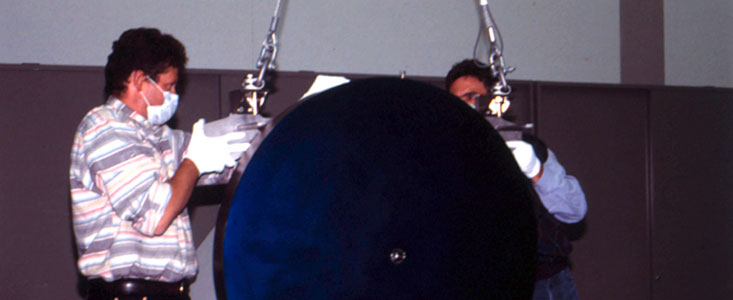Communiqué de presse
First M2-Unit and Beryllium Mirror Delivered to ESO
12 décembre 1997
Just as the first 8.2-metre Zerodur VLT primary mirror (M1) is arriving at the Paranal Observatory, there are also good news about the first of the 1.2-m Beryllium VLT secondary mirrors (M2) and its Supporting Unit . This assembly is placed at the top of the VLT 'telescope tube'.
The positioning of the M2 mirror is computer-controlled and it forms part of the VLT Active Optics System that maintains the optical quality of the VLT. During observations in the infrared spectral region, it is used in a `chopping mode' which allows to shift rapidly between the celestial object being observed and a neighbouring sky field in order to improve the signal-to-noise ratio. For this reason, the secondary VLT mirrors and their mechanical support systems have to be very light. This is why it was decided to use for the first time ever the very light, exotic metal Beryllium for a large telescope mirror.
These critical parts of the Very Large Telescope have now successfully passed the final and most crucial phase of their acceptance tests in the integration hall of Dornier Satellitensysteme (Friedrichshafen, Germany). This concludes a period of more than seven months of severe tests performed to guarantee that the Secondary Unit and its mirror meet the stringent requirements necessary to ensure the full optical quality of the VLT. This period has been characterized by a close interaction between the Dornier and the ESO team following the project to establish the complex test procedures and to review the results.
This programme started in May 1997 with the testing of the computer software, closely followed by the testing of the electro-mechanical unit, done with the help of a light-weighted dummy mirror. The test results, although successful, lead to a number of improvements and further optimization, performed by Dornier during the following months.
During the same period, REOSC Optique in Paris - the firm that is responsible for the polishing of the giant 8.2-m primary mirrors (M1) - completed the final polishing of the first Beryllium mirror. After integration with its titanium support system, and following extensive optical testing, it was delivered to Dornier in September 1997.
There, the mirror was dynamically tested to determine its inertia and the accurate position of its center of gravity, both crucial elements for the proper balancing of the chopping mechanism. In October, the M2 mirror was then inserted for the first time into the M2 Support Unit to check the differences between the dummy and the real mirror. Finally, a test setup with the real telescope spiders that carry the M2 and its support was prepared and assembled in the integration hall at Dornier in November. Due to the flexible mounting, it was possible to detect any, even very tiny imbalance in the M2 Unit that might possibly affect the telescope pointing.
These final tests were successful and have now lead to provisional acceptance by ESO of the M2 Unit. They have shown full compliance with the ESO chopping and tip-tilt (field stabilization) requirements and have also demonstrated the feasibility to tune the system for active rejection of unwanted mechanical resonances.
The ESO engineers are thus optimistic about the upcoming integration of the first M2 Unit into the first VLT Unit Telescope (UT1). The M2 Unit is now being packed and will soon be shipped to the Paranal Observatory in its special container.
More information is available at the ESO website about the VLT project.
A propos du communiqué de presse
| Communiqué de presse N°: | eso9732 |
| Legacy ID: | Photo 34a-b/97 |
| Nom: | Mirror, Very Large Telescope |
| Type: | Unspecified : Technology : Observatory : Telescope |
| Facility: | Very Large Telescope |


